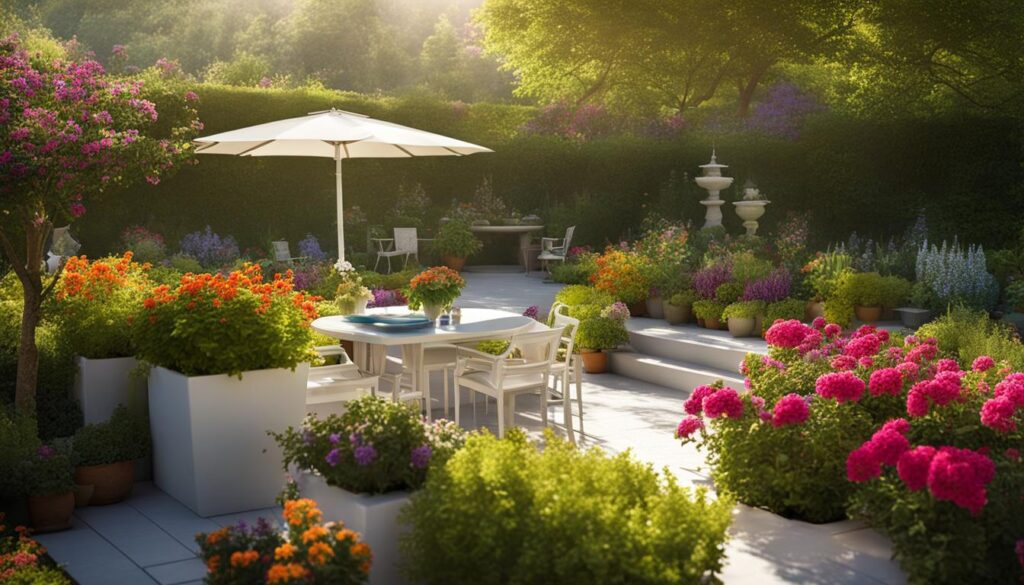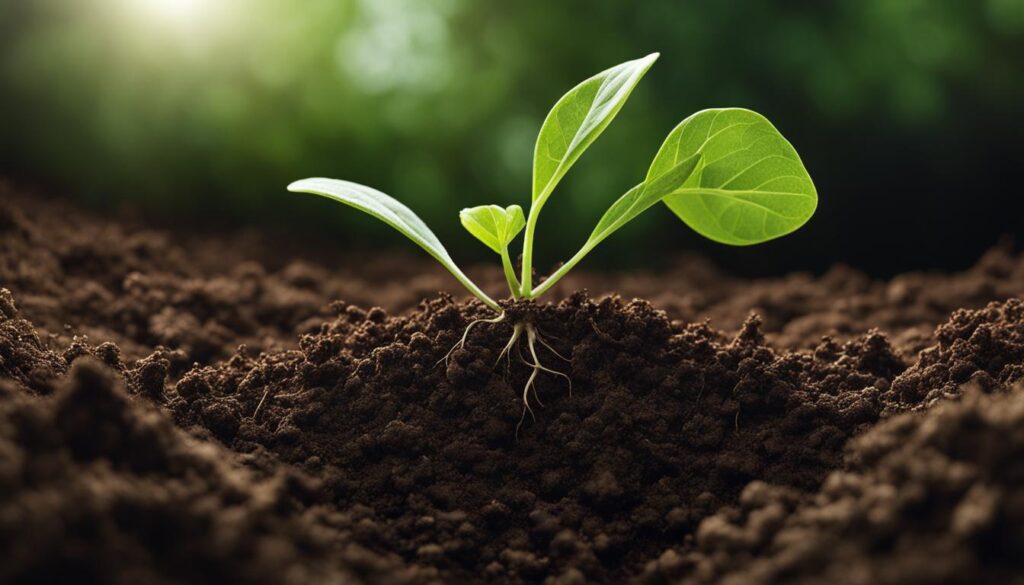Urban farming has become increasingly popular as city dwellers look for creative ways to bring nature into their daily lives and create a green heaven right in their own homes. Terrace garden design, in particular, offers a fantastic solution for those seeking to maximize their limited outdoor living space and cultivate a flourishing environment. Whether you are brand new to gardening or just interested in expanding your existing green space, this guide will provide you with thoughtful terrace garden ideas for beginners that can help turn your rooftop or balcony into a lush, vibrant oasis.
Key Takeaways
- Terrace gardening offers a versatile solution for urban dwellers looking to create their own green haven.
- Planning is crucial, including preparing the space, designing the layout, and selecting appropriate plants.
- Consider terrace garden benefits, such as heat regulation, insulation, and providing habitat for local fauna.
- For beginners, start with easy-to-grow plants like chili and coriander that are fast-growing and low-maintenance.
- Prioritize soil quality, organic fertilization, and proper watering schedules to promote healthy plant growth.
- Invest in organic pest control methods and natural garden care to maintain a thriving terrace garden environment.
- Ensure proper sunlight and airflow to encourage optimal growth in your terrace garden oasis.
Understanding Terrace Gardening Essentials
Defining a Terrace Garden
A terrace garden is essentially a garden created on a rooftop or terrace, allowing homeowners to incorporate various rooftop garden ideas tailored to suit the available space, whether limited or expansive. The versatility of terrace gardens allows for the cultivation of a diverse selection of plants, adapted to the unique conditions of each rooftop environment, ultimately contributing to urban greenery.
Benefits of Urban Terrace Gardens
Practicing terrace gardening offers a plethora of benefits, such as:
- Heat regulation: Terrace gardens help regulate the temperature within the building, acting as effective insulators during varied seasons.
- Insulation: They also aid in soundproofing, adding an extra layer of protection against noise pollution.
- Ecosystem for wildlife: Terrace gardens create habitats for local fauna, promoting biodiversity within urban areas.
- Carbon footprint reduction: Cultivating plants within a terrace garden contributes positively to reducing carbon emissions and promoting sustainable living.
- Nutritional benefits: Growing your own vegetables without pesticides results in healthier, fresher produce for your consumption.
Prepping Your Space for a Terrace Garden
Preparing your terrace space for gardening involves several important steps:
- Waterproofing: Ensure that waterproofing is in place to prevent leakages and potential structural damage.
- Drainage systems: Maintain efficient drainage systems to facilitate proper water flow and avoid waterlogging.
- Structural weight limits: Consider the weight limits of the terrace’s structural elements to avoid any damage or potential hazards.
- Layout planning: Plan the garden layout carefully, dictating the placement and selection of plants based on their sunlight needs, which can be especially crucial for small terrace garden ideas.
By addressing these essential aspects of terrace garden preparation, you can ensure your rooftop space is ready for a flourishing green oasis.
Designing Your Terrace Garden Layout
Creating a terrace garden layout is an essential step in transforming your rooftop into an urban green space. By combining design elements that suit your preferences with practical considerations for plant placement and growth requirements, you’ll craft a garden layout that is both visually appealing and functional.
Begin by determining the scope of your garden. You may want to start with a modest space filled with pots and containers, or you might have plans for a full-fledged green oasis brimming with plants of all types. Whatever your intentions, ensure that the layout accommodates the light and spacing requirements of your chosen plantings.
- Evaluate available space: Measure your rooftop area and take note of its features, such as walls, vents, or skylights. This information will be invaluable in designing an efficient garden layout that maximizes space usage.
- Consider sunlight and shade: It’s critical to assess the amount of sunlight and shade your rooftop receives throughout the day. Different plant varieties have unique light requirements, so ensure that your chosen plants receive appropriate exposure for optimal growth.
- Plan for walking paths and seating areas: In addition to space for plants, it’s essential to leave room for paths and seating areas. There’s nothing like relaxing in your own rooftop retreat, surrounded by the beauty of your terrace garden.
Remember that your terrace garden layout should be both practical and aesthetically pleasing. Keep these considerations in mind as you create your rooftop garden design:
- Determine focal points for eye-catching containers, sculptures, or garden features.
- Consider using vertical space by incorporating trellises or railings to support climbing plants.
- Arrange container groupings in odd numbers to create visual interest, and combine various textures and colors for a vibrant display.
- Maximize small spaces by using planters on wheels or incorporating modular planting systems.
A well-designed terrace garden layout will help your garden flourish, ensuring that you have a successful rooftop gardening experience. Keep these design principles and garden planning tips in mind to create the perfect oasis atop your urban dwelling.
Selecting Plants for Terrace Gardening
Choosing the right plants for your terrace garden is crucial for its success, especially when you are just starting your gardening journey. It is essential to consider the ease of growth, aesthetics, and functionality of the selected plants for an optimal gardening experience.
Easy-to-Grow Plants for Beginners
As a beginner, it is advisable to start with plants that are easy to grow, low-maintenance, and adapt well to your terrace garden’s localized conditions. Some fast-growing plants, ideal for beginners, include:
- Chili
- Coriander
- Basil
- Mint
- Tomatoes
- Spinach
These plants are not only easy to grow but also provide you with fresh, organic produce right from your terrace garden, adding value to your gardening experience.
Combining Aesthetics and Functionality
When selecting plants, it is important to combine aesthetic appeal with functionality, ensuring that your terrace garden is visually pleasing while also yielding usable produce. Some plants ideal for an Aesthetic terrace garden include:
- Fragrant Jasmine
- Lavender
- Marigolds
- Geraniums
At the same time, focusing on functional plants, such as vegetables and herbs, ensures that you enjoy the practical benefits of gardening on your terrace. Some functional plants to consider include:
- Tomatoes
- Spinach
- Eggplants
- Peppers
- Strawberries
Remember that it is essential to account for the local climatic conditions when selecting your plants, ensuring you choose species that will thrive and allow for successful functional gardening on your terrace.
Soil and Fertilization Strategies for Healthy Plants
A thriving terrace garden begins by choosing the right soil and fertilization methods. The soil composition plays an essential role in providing the necessary nutrients while supporting drainage, aeration, and moisture retention.
A blend of the following components is recommended for terrace garden soil:
- Regular garden soil
- Compost
- Coir peat (or sand)
- Vermicompost
Mixing equal parts of these ingredients creates a balanced environment that fosters healthy plant growth. In addition to this soil mixture, proper fertilization is crucial for producing a bounty of fruits, vegetables, and flowers in your terrace garden.
Organic Fertilization
Organic fertilization is an eco-friendly option that nurtures plant growth while preserving the chemical and biological balance of your garden. Organic fertilizers, such as compost and vermicompost, enhance the soil structure, improve the availability of nutrients, and result in more productive plants.
- Composting: The process of composting involves decomposing organic waste materials (kitchen scraps, dried leaves, etc.) into a nutrient-rich substance that enriches the soil.
- Vermicomposting: Vermicomposting is similar to composting, but it relies on earthworms to break down the organic matter, producing high-quality humus and fertilizing minerals for your terrace garden.
In addition to these organic fertilization techniques, you can also create DIY organic pesticides to keep your plants healthy without using harmful chemicals. A simple yet effective homemade solution can be made from water, green chillies, and garlic – applied once a week to help deter pests. Using organic methods in soil fertilization and pest control promotes overall garden health and yields.
| Organic Fertilizer | Description | Benefits |
|---|---|---|
| Compost | A nutrient-rich substance created by decomposing organic waste materials | Improves soil structure and nutrient availability |
| Vermicompost | High-quality humus and fertilizing minerals produced by earthworms feeding on organic matter | Enhances soil fertility and supports healthy plant growth |
By incorporating these soil and fertilization strategies into your terrace garden, you will be well on your way to cultivating healthy, robust plants in an eco-friendly manner. This not only benefits your garden’s inhabitants but also contributes positively to the environment as a whole.
Maintenance and Care for Your Terrace Garden
Proper care and attention are vital for the success of your terrace garden. This includes paying close attention to watering practices, organic pest control, and ensuring that your plants receive sufficient sunlight and air circulation.
Watering Techniques and Schedules
Regular watering is essential for a thriving terrace garden, but the frequency depends on the plant species and the local climate. One way to determine your garden’s watering needs is to observe the moisture levels in the soil, adjusting your watering schedule accordingly. To avoid over-watering, you can use the following techniques:
- Water in the morning or evening when the sun is less intense.
- Utilize drip irrigation or soaker hoses to deliver water directly to the roots.
- Place saucers underneath pots to collect excess water.
Organic Pest Control Methods
Organic pest control is an essential aspect of maintaining a healthy terrace garden without resorting to harmful chemicals. One effective DIY pesticide solution can be made using green chilies, garlic, and water. To prepare this natural remedy, simply blend the ingredients together, strain the liquid, and spray it onto your plants once a week. Here are some additional organic pest control methods:
- Remove and dispose of infected leaves and plant parts promptly.
- Introduce beneficial insects, such as ladybugs and lacewings, to control pests.
- Regularly inspect plants for signs of infestation, taking action early.
Ensuring Proper Sunlight and Airflow
Proper sunlight exposure and airflow are crucial to the overall health and well-being of your plants. To maximize sunlight exposure and facilitate air circulation, keep the following tips in mind during the planning and maintenance phases of your terrace garden:
| Ideal Sunlight Exposure | Plant Categories |
|---|---|
| Full sun (6+ hours) | Tomatoes, peppers, eggplants, herbs |
| Partial sun (4-6 hours) | Lettuce, spinach, kale, chard |
| Shade (less than 4 hours) | Mint, chives, parsley, ferns |
Furthermore, position plants that require similar sunlight conditions together and ensure that air can circulate freely around the plants through regular pruning and thinning of foliage.
Taking proper care of your terrace garden through attentive watering, organic pest control, and regular observation of sunlight requirements is critical to achieving a flourishing urban oasis.
Which Gardening Structure is Best for Terrace Gardening for Beginners?
When it comes to terrace gardening, beginners may consider a geodesic dome versus a greenhouse. A geodesic dome offers a unique and aesthetic appeal, along with sturdy construction. On the other hand, a greenhouse provides a controlled environment for growing various plants. Both options have their benefits for terrace gardening.
Conclusion
Terrace gardening provides urban dwellers with an incredible opportunity to embrace sustainable living, transforming their living spaces into a personal green oasis. This environmentally friendly approach to urban gardening offers numerous benefits, ranging from heat regulation and insulation within the surrounding building to enhancing individual health and well-being.
It’s essential for beginners to spend time researching and planning their terrace garden design, taking into account factors such as waterproofing, drainage systems, and weight limitations. This ensures that the layout is optimized for the chosen plants, promoting their successful growth and cultivation.
By carefully selecting plants that are both low-maintenance and suitable for the local climate, beginners can create a beautiful and functional terrace garden that yields delicious organic produce. With diligent care and maintenance, even inexperienced gardeners can develop a thriving green sanctuary in the heart of city life, contributing to the ongoing movement towards sustainable living and urban gardening.











